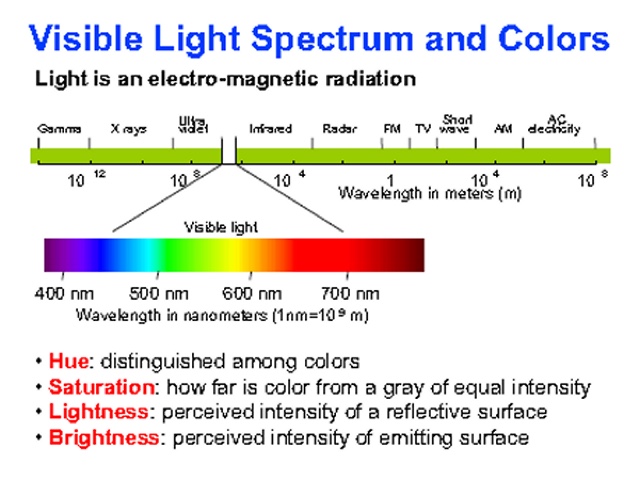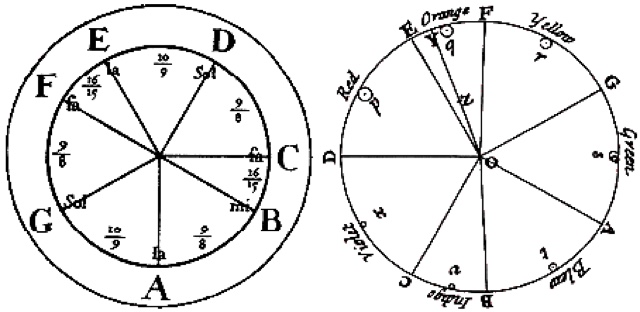Color Is Light
Color is defined as the quality of an object or substance with respect to light reflected by the object, usually determined visually by measuring the hue, saturation, and brightness of the reflected light.
• HUE: a gradation of color; the attribute of color that permits them to be classified as red, yellow, green, blue or an immediate between any contiguous pair of these colors.
• SATURATION: how vivid and intense the hue is; the degree of purity in a hue.
• CHROMA: a quality of color combining hue and saturation; how pure a hue is in relation to gray.
• INTENSITY: how bright or dull a hue is,
• LUMINANCE VALUE: a measurement of the amount of light reflected from a hue.
• SHADE: a variation of a hue with the addition of black.
• TINT: a variation of a hue with the addition of white.
How We See Color
Our eyes and brain translate light into color. How? There are hundreds of photoreceptors located in our retinas: rods and cones. Rods are used in dim light and help us see in shades of gray: black and white. Cones allow us to see colors: red, green and blue. The photoreceptors process light into nerve impulses and pass them along to our brain's cortex via the optic nerve.
As light bounces off of the objects around us, it gives us the ability to see; the overlap of the cones or various concentrations of RGB (red, green and blue) allow us to see the other colors of the visible spectrum.
Black and White
Which one is a color? Neither are specified as colors according to physicists. Why? Because neither black nor white have specific wavelengths and therefore cannot be colors.
White is the sum of all colors; black is the absence of light and therefore cannot be a color. Why? Because color is light.
Argument: if you mix all of the colors together, does this not produce black? No, it does not, it produces a very, very dark brown, but not true black.
Discovery of Color
Sir Isaac Newton was the first to understand the rainbow by shining a white light through a prism. He then observed the way each color of light would bend as it passed through the prism. He devised the first color circle using ROY G BIV (Red, Orange, Yellow, Green, Blue, Indigo, and Violet) like the seven notes of a musical scale.
Albert Henry Munsell, an American painter and teacher of art, invented the Munsell Color System. (Pantone uses this today.) He invented this color system so there would be a universal system for the names of colors. There are thousands of colors in this system.
Have you ever walked into a paint store? All of those color swatches are the Munsell Color System.
The Color Wheel
"All colors are the friends of our neighbors, and the lovers of their opposites."
-Marc Chagall
Primary*: red, yellow and blue
Secondary: violet, green and orange; the mixing of two primary colors
Tertiary: the mixing of primary and secondary colors
Complimentary: the opposite colors on the color wheel.
*Primary colors are actually RGB but as far as color wheels go... they are still considered to be red, yellow and blue.
Why Color Matters
Imagine life without color: you'd live in a white house with white walls, floors and ceilings, white furnishings, white everything. You'd wear white too. You'd look outside your window and see nothing but whiteness. How dull life would be without color!
Now add just a splash of color... your eyes would direct to the colors. Color is everything! It affects us both mentally and physically, it affects our taste and smell, it informs us and increases awareness, it is a form of communication.
Have you ever eaten a white Popsicle? What flavor was it? It's very difficult for us to figure out flavor without color.
Sources
Merriam, Dictionary Reference, Worqx, Desktop Publishing, Munsell, Wikipedia, Empowr, Color Matters, Pantone, Mobile Burn, Live Science, Ask a Biologist, Yahoo, images from Google







